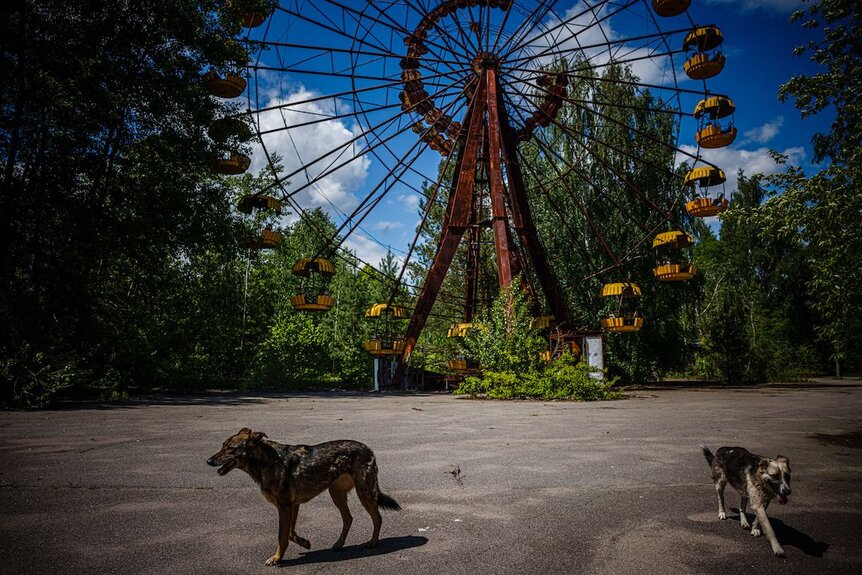Create a free profile to get unlimited access to exclusive videos, sweepstakes, and more!
Decoding the mutant dogs of Chernobyl’s exclusion zone
If they have any superpowers, they're keeping them well hidden.

In John Carpenter’s 1982 science fiction horror classic The Thing, a rugged team of Antarctic explorers encounters a bizarre alien entity frozen in the permafrost. Exposure to the creature results in a rapid and horrifying death, and survivors are left to deal with the twisted facsimile of their friends or loved ones that the creature leaves behind. Only in that strange scenario can you gaze upon something which looks like your friend or looks like a dog but isn’t.
Here in the real world, we don’t have access to any body-bending extraterrestrial horrors (not that we’re complaining), which makes it difficult to study the ways an organism might change through exposure. But we do have access to lingering radiation, which is almost as revealing.
In 1986, the fourth reactor at the Chernobyl nuclear power plant experienced a cataclysmic malfunction, which we’re still dealing with today. The plant, the remains of which are near Pripyat in northern Ukraine, was overdue for a safety test during the early morning hours of April 26. The test required that power production in the reactor be reduced, in order to test safety mechanisms meant to prevent the type of disaster which was about to occur.
RELATED: 'The Thing' at 40: The cast & crew's definitive history of John Carpenter's masterpiece
As the test begun, operators reduced power output from the station as directed, but it dropped lower than expected, a result of xenon biproducts produced during normal operation. Scrambling to fix the error, operators removed a bunch of control rods which stabilized the reaction, but at a lower level than intended or desirable. The reduction in power and temperature inside the reactor slowed the burn off of xenon biproducts, which further destabilized the reaction.
For reasons which aren’t totally clear, around 1:24 in the morning, operators pressed the AZ-5 button, initiating an emergency shutdown of the reactor. In response, all of the control rods were plunged back into the reactor water. That should have shut the reactor down, but there was a problem in the design which no one had anticipated. The tip of each control rod was equipped with graphite, which mediates the reaction. When all of the rods were plunged into the water, the graphite tips all went to the bottom of the reactor, where they displaced neutron absorbing water, temporarily increasing the reaction. Unfortunately, the reactor couldn’t bear the additional load all at once. Within seconds, the reactor’s power level spiked, the water in the reactor rapidly transformed from liquid into steam, and reactor four exploded.
The force of the blast sent radioactive debris flying and the plant continued to dump radiation into the air and local ecosystem for months while the cleanup effort proceeded. Ultimately, an exclusion zone with a radius of 30 kilometers (19 miles) around the reactor was set up. Ostensibly, there aren’t any people living in the exclusion zone (commonly called "the zone" by locals) but that isn’t actually true. Immediately following the accident, there were approximately 1,200 people who simply refused to leave their homes. Eventually, authorities relented, and a sort of unspoken truce was established. Today, fewer than 200 people remain inside the zone, most of them having died or moved on in the intervening three-and-a-half decades.
People weren’t the only creatures who refused to leave, despite efforts by Soviet officials to rid the area of anything that walks, crawls, or flies. The worry was that anything in the area might migrate, carrying radioactive materials with them. Animals, of course, don’t cooperate or follow orders, and as a result there is a moderately sized population of semi-wild dogs living in and around the derelict reactor.
Now, for the first time, an international team of researchers have conducted a genetic survey of the dogs living in and around the still-radioactive exclusion zone, in the hope of better understanding how persistent ionizing radiation impacts ecosystems. Their results were published in the journal Science Advances.
We have good reason to believe that heightened levels of radiation in the environment at places like Chernobyl and the site of the Fukushima disaster cause changes in the ecosystems nearby, but it’s unclear how or how much. Chernobyl is the perfect place to figure that out because of the incredibly high levels of radiation present there. According to researchers, there was a significantly higher amount of radiation released at Chernobyl than at Fukushima, including roughly six times more cesium-137, a radionuclide with a half-life of more than 30 years.
Unlike the people living in the zone, who are largely of one generation which has lived there since before the disaster, the dogs are several generations removed from the ones who lived through the explosion. They provide an opportunity to see the long-term effects of radiation not on an individual but on a population and an ecosystem over the course of generations.
RELATED: Hold the drinks: Booze made from radioactive Chernobyl apples confiscated by government authorities
Researchers looked at over 300 dogs representing three different populations at varying distances from the reactor site. While some were collected within rock-throwing distance of the reactor itself, others lived as far away as 45 kilometers, technically outside the exclusion zone but close enough for heightened exposure. Blood samples were taken from each of the dogs during veterinary procedures and examined for genetic variation.
Their findings confirmed that dogs living in and around Chernobyl are genetically distinct from purebred dogs and from free-breeding dogs elsewhere in the world. Moreover, dogs living at the reactor site were genetically distinct from dogs living 45 kilometers away, supporting the hypothesis that radiation exposure is a driving factor of the changes.
While scientists can say that dogs in the area are genetically distinct, they can’t yet say to what degree radiation drove those changes or to what degree any mutations are beneficial for living in that environment. Still, these findings should provide a baseline for future studies, which could reveal the role of ionizing radiation in the adaptive evolution of animals exposed to it. By comparing these sequences from the Chernobyl dogs to those of dogs living in non-radioactive locales, they might be able to identify specific beneficial mutations.
That will be good information to have when it’s our turn to live in an irradiated wasteland or fight a body-snatching alien from another world.
You probably want to avoid the exclusion zone, but you can watch The Thing, available now from Universal Entertainment.



























